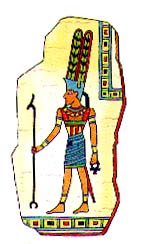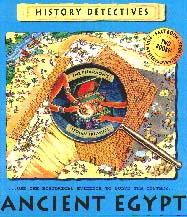|
________________
CM . . . .
Volume VI Number 20 . . . . June 9, 2000
excerpt: You are led into a royal tent, pitched near the pyramids, and bow before the pharaoh and his queen. "I have summoned you to ask you to find who stole the treasure from the pyramid of my forefather," he says. "You must not fail me." A man steps forward. "Great pharaoh, let me find the thieves," he says. "I will bring them to justice whoever they are." The queen puts up her hand for silence, "Thank you, Hori, but as leader of the pharaohs guard you are well known throughout Egypt. For this task we need a stranger."  Middle years students who have an interest in history and mystery should enjoy this book set
immensely. It contains an introductory history book on ancient Egypt and a paperback mystery
adventure story. The two books are very compatible and together create a stimulating educational
experience.
Middle years students who have an interest in history and mystery should enjoy this book set
immensely. It contains an introductory history book on ancient Egypt and a paperback mystery
adventure story. The two books are very compatible and together create a stimulating educational
experience.It is clear that the ancient Egyptians were a god-centered people; the primary focus of life was religious observations and a concern for the afterlife. However, many books tend to focus almost exclusively on these aspects, giving the impression that Egyptians were entirely death-centered. They forget that people had to make lives for themselves: farmers had to sow and harvest; artisans had make goods; merchants had to sell their wares; soldiers had to fight; leaders had to govern; and family life had to go on. If these were not done well, Egypt could not have existed as a Mediterranean and African power for many centuries. To his credit, Philip Ardagh has integrated common life experience into the religious-social context of society, thereby creating a nicely balanced picture of ancient Egyptian life. The well-written and illustrated chapters naturally include "The Pharaohs," "Building a Pyramid," and "The Afterlife" but also examine "On the Nile," "Life in a Villa" and "Life as a Child." Although an individual student may want to attempt solving the mystery of the stolen treasure, it is an excellent activity for a pair or small group. Students should not attempt to rush through the activity. The mystery is moderately complex, but the solution can be properly deduced from the textual and pictorial evidence. Readers need to examine the fact-based text closely if they are to solve certain questions within the mystery. The more questions students answer, the higher the point value they will receive. There are opportunities for assessment in reading comprehension, research skills and cooperative learning. Hopefully, some students might be motivated to create their own ancient Egyptian mysteries for other students to solve. Highly Recommended. Ian Stewart lives in Winnipeg and is a regular contributor to CM and the book review pages of the Winnipeg Free Press.
To comment on this title or this review, send mail to cm@umanitoba.ca.
Copyright © the Manitoba Library Association.
Reproduction for personal use is permitted only if this copyright notice
is maintained. Any other reproduction is prohibited without
permission.
Published by
TABLE OF CONTENTS FOR THIS ISSUE - June 9, 2000.
AUTHORS |
TITLES |
MEDIA REVIEWS |
PROFILES |
BACK ISSUES |
SEARCH |
ORDER |
CMARCHIVE |
HOME
|
